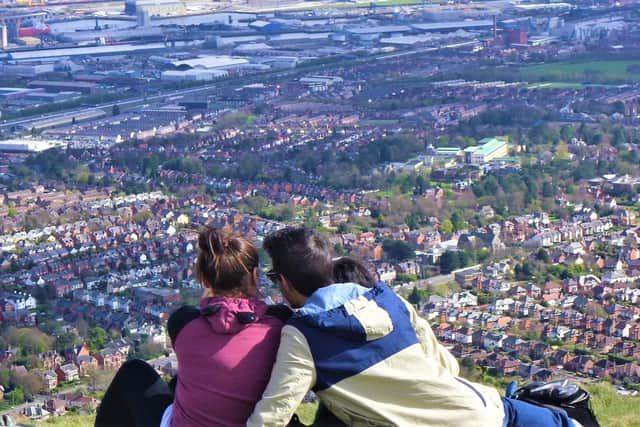Election 2022: Unionism’s vote share has been ebbing away in North Belfast for years – must unionists now settle for two out of five seats?
and live on Freeview channel 276
North Belfast is where Sinn Fein infamously distributed election leaflets noting the shifting balance of Catholics and Protestants.
Drawn from the last census in 2011, that data showed there were 48,126 people of a Catholic background in the seat (46.94%) and 46,821 from a Protestant background (45.67%).
Advertisement
Hide AdAdvertisement
Hide AdThe leaflet then described them as “48,126 nationalists and 46,821 unionists” – recognising no distinction between politics and religion and making the upcoming election nothing more than a battle of population size.


Whilst those leaflets in 2015 caused much uproar (with North Belfast MLA Gerry Kelly saying that they should never have appeared) they did highlight the fact that the constituency – more so than almost any other – has long been on a knife edge between nationalist/republican parties and unionist ones, tilting ever more against the latter with each passing year.
This drift culminated in DUP stalwart Nigel Dodds losing his House of Commons seat to Sinn Fein’s John Finucane in 2019, having held it for the previous 18 years.
According to data in the Ulster University-run ARK election archive, during the 2005 Westminster election the combined UUP and DUP vote in the seat came to 53%.
Advertisement
Hide AdAdvertisement
Hide AdThen it dwindled until by the 2019 Westminster election it had reached 43.1%.
That year unionism at large, in an attempt to cling on to the Commons seat, fielded a sole candidate in the form of Lord Dodds, whilst the SDLP bowed out to allow Mr Finucane to hoover up all the pro-united Ireland votes.
He duly seized the seat with 47.1% of the vote (in the process nearly mirroring the controversial religious divide leaflet from a few years earlier).
Not all of unionism’s loss has been nationalism’s gain; over the decades Alliance has seen their vote share rise and other “non-aligned” parties like People Before Profit have taken some traditional “green” votes.
DUP AIMS TO CONSOLIDATE, NOT EXPAND:
So – what does this all mean for the Stormont Assembly?
Advertisement
Hide AdAdvertisement
Hide AdBefore the changes to the size of Stormont in 2017, North Belfast had three DUP MLAs, two Sinn Fein ones, and one SDLP one.
After the 2017 election, the DUP kept only two (with Nelson McCausland losing out very narrowly on his place).
And instead of seeking to expand, the party is this year aiming to defend those two seats by fielding only two candidates: Phillip Brett and Brian Kingston.
Neither have been MLAs before; both formerly worked for Nigel Dodds, and have long served on councils (Belfast City in Mr Kingston’s case, and Newtownabbey & Antrim for Mr Brett).
Advertisement
Hide AdAdvertisement
Hide AdIn unionist terms they will vie for votes against Ron McDowell (TUV party secretary), Billy Hutchinson (PUP leader) and Julie-Anne Corr-Johnston (UUP).
It will be particularly interesting to see how the latter fares, given that the last time around she was a PUP candidate, meaning she is now locked in battle with her old boss.
On the pro-united Ireland side, there will be Gerry Kelly and Caral Ni Chuilin of Sinn Fein, and Nichola Mallon of the SDLP, plus Sean Mac Niocaill of Aontu.
However, delving deep into the stats from 2017 (see below) reveals that Kelly, Ni Chuilin, and Mallon were the top three candidates in terms of first preference votes – so could that leave the DUP vulnerable to someone like Alliance’s Nuala McCallister, especially if the DUP vote falls due to protocol-related anger?
Advertisement
Hide AdAdvertisement
Hide AdMr Kingston said “I have not seen any sea change” of the kind predicted by the DUP’s rivals, but that he had found some voters to be under a “false impression” about where the party stood on the issue, stressing the DUP’s opposition to it.
“I recognise she [Nuala McAllister] was the last candidate eliminated last time when it went from six to five MLAs, but we of course were running three then,” he said. “This is the first time we’ve run two. Certainly from my experience on the doors, I think the DUP vote is holding up.”
2019 ASSEMBLY ELECTION RESULTS:
Gerry Kelly, Sinn Fein, 6,275 first preference votes, 15.1% vote share: ELECTED
Caral Ni Chuilin, Sinn Fein, 5,929, 14.3%: ELECTED
Nichola Mallon, SDLP, 5,431, 13.1%: ELECTED
Paula Bradley, DUP, 4,835, 11.7%: ELECTED
William Humphrey, DUP, 4,418, 10.6%: ELECTED
Nelson McCausland, DUP, 4,056, 9.8%
Nuala McAllister, Alliance, 3,487, 8.4%
Robert Foster, UUP, 2,418, 5.8%
Julie-Anne Corr-Johnston, PUP, 2,053, 4.9%
Fiona Ferguson, PBP, 1,559, 3.8%
Mal O�’Hara, Green, 711, 1.7%
Gemma Weir, Workers Party, 248, 0.6%
Adam Millar, Ind., 66, 0.2%
2017 WESTMINSTER ELECTION RESULTS:
John Finucane, Sinn Fein, 23,078 votes, 47.1%
Nigel Dodds, DUP, 21,135, 43.1%
Nuala McAllister, Alliance, 4,824, 9.8%
YOUR 2022 ELECTION CANDIDATES:
Phillip Brett (DUP)
Julie-Anne Corr-Johnston (UUP)
Fiona Ferguson (PBP)
Billy Hutchinson (PUP)
Gerry Kelly (SF)
Lily Kerr (Workers Party)
Brian Kingston (DUP)
Sean MacNiocaill (Aontu)
Nichola Mallon (SDLP)
Nuala McAllister (All)
Ron McDowell (TUV)
Caral Ni Chuilin (SF)
Mal O’Hara (Green)
Stafford Ward (Ind)
More from this reporter:
Advertisement
Hide AdAdvertisement
Hide Ad